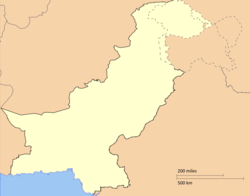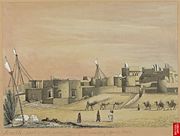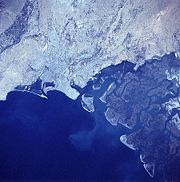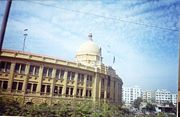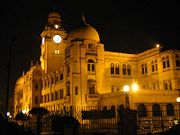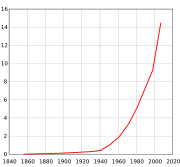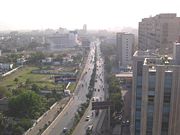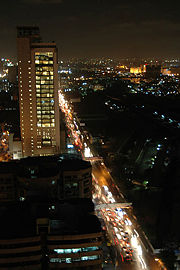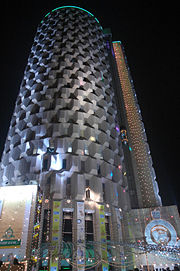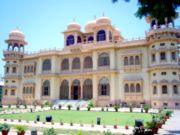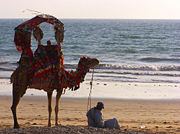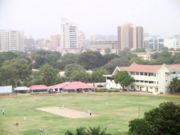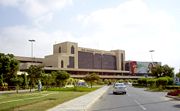Karachi
2008/9 Schools Wikipedia Selection. Related subjects: Asia; Asian Cities
| Karachi کراچی |
|||
|
|||
| Location within Pakistan | |||
| Location within Pakistan | |||
| Coordinates: | |||
|---|---|---|---|
| Country | |||
| Province | Sindh | ||
| Municipal Committee | 1853 | ||
| Municipal Corporation | 1933 | ||
| Metropolitan Corporation | 1976 | ||
| City District Government | 14th August 2001 | ||
| City Council | City Complex, Gulshan Town | ||
| Towns |
18
|
||
| Government | |||
| - Type | City District | ||
| - City Nazim | Mustafa Kamal (Muttahida Qaumi Movement) | ||
| - Naib Nazim | Nasreen Jalil | ||
| Area | |||
| - Total | 3,527 km² (1,356 sq mi) | ||
| Elevation | 8 m (26 ft) | ||
| Population (2008) | |||
| - Total | 12,461,423 | ||
| - Density | 3,533.2/km² (9,189.8/sq mi) | ||
| Time zone | PST ( UTC+5) | ||
| Area code(s) | 021 | ||
| Website: http://www.karachicity.gov.pk City-District Government of Karachi | |||
Karachi ( Sindhi: ڪراچي, Urdu: کراچی) is the provincial capital of Sindh province and the largest city in Pakistan. Karachi is the world's second largest city proper behind Mumbai in terms of population, which exceeds 12 million. In terms of population, it is one of the largest cities in the world, and is Pakistan's premier centre of banking, industry, and trade. Karachi is also the home of Pakistan's largest corporations that are involved in entertainment, publishing, software development, medical research. It also serves as a major hub of higher education in South Asia, and the wider Islamic World.
Karachi was the original capital of Pakistan until the construction of Islamabad, and is the location of Karachi Port, one of the regions largest and busiest ports. The city's population has since increased dramatically after the partition of British India forced hundreds of thousands of Urdu and Gujrati speaking "Mohajirs"(refugees) to settle in the city. Since independence from Britain in 1947, the city's vibrant economy has attracted migrants from all over Pakistan, and beyond. Despite a history of political turmoil, the city continues to attract those seeking prosperity.
Karachi city is expansive, and is over 3,530 square kilometres (1,363 sq mi) in area. It is locally known as the "City of Lights" (روشنين جو شهر) for its liveliness, and the "City of the Quaid" (شهرِ قائد), having been the birth and burial place of Quaid-e-Azam Muhammad Ali Jinnah, the founder of Pakistan, who also made the city his home after Pakistan's independence.
Karachi's Founding and Colonial History
Karachi was founded as "Kolachi" by Baloch tribes from Balochistan and Makran who established a small fishing community in the area . Descendants of the original community still live in the area on the small island of Abdullah Goth, which is located near the Karachi Port. The original name "Kolachi" also survives in the name of a well-known Karachi locality named "Mai Kolachi."
The city remained a small fishing village until the British seized control of the offshore and strategically located island of Manora. Thereafter, authorities of the British Raj embarked on a large-scale modernization of the city in the 19th century with the intention of establishing a major and modern port which could serve as a gateway to Punjab, the western parts of British India, and Afghanistan. Britain's competition with imperial Russia during the Great Game also heightened the need for a modern port near Central Asia, and so Karachi prospered as a major centre of commerce and industry during the Raj, attracting communities of: Africans, Arabs, Armenians, Goan Catholics, Jews (both Sephardic and Ashkenazi), Lebanese Christians, Malayans, and Zoroastrians - in addition to the large number of British businessmen and colonial administrators who established the city's poshest locales, such as Clifton.
British colonialists embarked on a number of public works of sanitation and transportation - such as gravel paved streets, proper drains, street sweepers, and a network of trams and horse-drawn trolleys. Colonial administrators also set up military camps, a European inhabited quarter, and organized marketplaces, of which the Empress Markets are most notable. The city's wealthy elite also endowed the city with a large number of grand edifices, such as the elaborately decorated buildings that house social clubs, known as 'Gymkhanas.' Wealthy businessmen also funded the construction of the Kothwari Parade (a large seaside promenade) and the Frere Hall, in addition to the cinemas, and gambling parlours which dotted the city.
Karachi witnessed relatively few events associated with the Indian movement for independence. Perhaps because of effective colonial administration, the city witnessed only few outbursts of anti-British sentiment in the city, unlike most other major cities in British India, which were often the scene of violence and widespread "civil disobedience." As the movement for Indian independence almost reached its conclusion, the city suffered widespread outbreaks of communal violence between Muslims and Hindus. In response to the perceived threat of Hindu domination, in combination with Sindhi Muslim resentment towards wealthy Sindi Hindus, the province of Sindh became the first province of British India to pass the Pakistan Resolution, in favour of the creation of the Pakistani state. The ensuing turmoil of Partition lead to the expulsion of most of Karachi's wealthy Hindu community. While many poorer Hindus, Christians, and wealthy Zoroastrians remained in the city, Karachi's native Sindhi Hindu community was almost entirely uprooted, and replaced by migrants from India seeking refuge from the anti-Muslim pogroms which were taking place there.
Post-Independence
Upon the independence of Pakistan in 1947, the city was selected by the governing Muslim League to become the national capital of Pakistan, which at the time also included modern day Bangladesh. Karachi was the focus for settlement by refugees from India, who drastically expanded the city's population and transformed the demographics, and economy. Karachi has since faced major infrastructural and socio-economic challenges, but modern industries and businesses have developed in the city, particularly in Korangi, and SITE.
The area of Karachi was known to the ancient Greeks by many names: Krokola, the place where Alexander the Great camped to prepare a fleet for Babylonia after his campaign in the Indus valley; 'Morontobara' (probably Manora island near Karachi harbour), from where Alexander's admiral Nearchus set sail; and Barbarikon, a port of the Indo-Greek Bactrian kingdom. It was later known to the Arabs as Debal, the starting point for Muhammad bin Qasim and his army in 712 CE.
The city was visited by Ottoman Admiral Sidi Ali Reis in 1550s and mentioned in his book Mirat ul Memalik (The Mirror of Countries), 1557 CE . The present city started life as a fishing settlement when a Baluchi fisherwoman called Mai Kolachi took up residence and started a family. The village that later grew out of this settlement was known as Kolachi-jo-Goth (Village of Kolachi in Sindhi). By the late 1700s the village was trading across the Arabian Sea with Muscat and the Persian Gulf region. A small fort was constructed for its protection, armed with cannons imported from Muscat. The fort had two main gateways: one facing the sea, known as Kharra Darwaaza (Brackish Gate) and the other facing the Lyari River known as the Mitta Darwaaza (Sweet Gate) . The location of these gates correspond to the modern areas of Kharadar (Khārā Dar) and Mithadar (Mīṭhā Dar).
In 1795, the village became a domain of the Balochi Talpur rulers. A small factory was opened by the British in September 1799, but was closed down within a year. After sending a couple of exploratory missions to the area, the British East India Company conquered the town on February 3, 1839. The town was later annexed to the British Indian Empire when Sindh was conquered by Charles James Napier in 1843. On his departure in 1847, he is said to have remarked, "Would that I could come again to see you in your grandeur!".
Karachi was made the capital of Sindh in the 1840s. On Napier's departure it was added along with the rest of Sindh to the Bombay Presidency. The British realized the importance of the city as a military cantonment and as a port for exporting the produce of the Indus River basin, and rapidly developed its harbour for shipping. The foundations of a city municipal government were laid down and infrastructure development was undertaken. New businesses started opening up and the population of the town began rising rapidly.
In 1857, the First Indian War for Independence broke out in the subcontinent and the 21st Native Infantry stationed in Karachi declared allegiance to rebels, joining their cause on September 10, 1857. Nevertheless, the British were able to quickly reassert control over Karachi and defeat the uprising. Karachi was known as Khurachee Scinde (i.e. Karachi, Sindh) during the early British colonial rule.
In 1864, the first telegraphic message was sent from India to England when a direct telegraph connection was laid between Karachi and London. In 1878, the city was connected to the rest of British India by rail. Public building projects such as Frere Hall (1865) and the Empress Market (1890) were undertaken. In 1876, Muhammad Ali Jinnah, the founder of Pakistan, was born in the city, which by now had become a bustling city with churches, mosques, courthouses, markets, paved streets and a magnificent harbour. By 1899 Karachi had become the largest wheat exporting port in the east. The population of the city was about 105,000 inhabitants by the end of the 19th century, with a cosmopolitan mix of Hindus, Muslims, Europeans, Jews, Parsis, Iranians, Lebanese, and Goans. By the turn of the century, the city faced street congestion, which led to India’s first tramway system being laid down in 1900.
By the time the new country of Pakistan was formed in 1947, Karachi had become a bustling metropolis with beautiful classical and colonial European styled buildings lining the city’s thoroughfares. Karachi was chosen as the capital of Pakistan and accommodated a huge influx of migrants and refugees after partition. The demographics of the city changed dramatically but it still maintained cultural diversity as new residents arrived from all parts of India. In 1958, the capital of Pakistan was moved from Karachi to Rawalpindi and then to Islamabad in 1960. This marked the start of a long period of decline in the city, marked by a lack of development. The 1980s and 1990s saw an influx of refugees from the Afghan war into Karachi. Political tensions between the Muhajir groups (descendants of migrants from the partition era) and other groups also erupted and the city was wracked with political and sectarian violence. Most of these tensions have now simmered down.
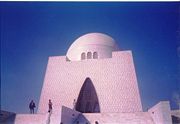
Karachi continues to be an important financial and industrial centre and handles most of the overseas trade of Pakistan and the central Asian countries. It accounts for a large portion of the GDP of Pakistan and a large proportion of the country's white collar workers. Karachi's population has continued to grow and is estimated to have passed the 20 million mark, although official figures still show a population of around 14.5 million. The current economic boom in Pakistan has also resulted in a new period of resurgence in the economy of Karachi.
Geography and climate
Karachi is located in the south of Sindh, on the coast of the Arabian Sea. The city covers an area of approximately 3,530 square kilometres (1,363 sq mi), comprised largely of flat or rolling plains, with hills on the western and northern boundaries of the urban sprawl. Two rivers pass through the city: the River Malir which flows from the east towards the south and centre, and the River Lyari, which flows from north to the south west. The Port of Karachi is a sheltered bay to the south-west of the city, protected from storms by the Sandspit Beach, the Manora Island and the Oyster Rocks. The Arabian Sea beach lines the southern coastline of Karachi. Dense mangroves and creeks of the Indus delta can be found towards the south east side of the city. Towards the west and the north is Cape Monze, locally known as Raas Muari, an area marked with projecting sea cliffs and rocky sandstone promontories. Some excellent beaches can also be found in this area.
Located on the coast, Karachi tends to have a relatively mild climate with low levels of average precipitation (approximately 250 mm per annum), the bulk of which occurs during the July-August monsoon season. Winters are mild and the summers are hot, however the proximity to the sea maintains humidity levels at a near-constant high and cool sea breezes relieve the heat of the summer months. Due to high temperatures during the summer (ranging from 30 to 44 degrees Celsius from April to August), the winter months (November to February) are generally considered the best times to visit Karachi. July, December and January have pleasing and cloudy weather when most of the social events, ranging from weddings to charity fundraisers, frequently take place. Tourists and expatriates visit Karachi in these months, Highest recorded is 47.8 °C (118.0 °F) and lowest is 5.0 °C (41.0 °F).
| Temperatures (1931-2002) | Jan | Feb | Mar | Apr | May | Jun | Jul | Aug | Sep | Oct | Nov | Dec | Annual |
| Highest maximum (°C) | 32.8 | 33.5 | 34.0 | 34.4 | 35.8 | 36.0 | 35.2 | 35.7 | 34.8 | 33.3 | 32.5 | 31.5 | 30.8 |
| Lowest minimum (°C) | 5.0 | 6.3 | 7.0 | 12.2 | 17.7 | 22.1 | 22.2 | 20.0 | 18.0 | 10.0 | 6.1 | 5.3 | 5.0 |
Government
The City of Karachi Municipal Act was promulgated in 1933. Initially the Municipal Corporation comprised the mayor, the deputy mayor and 57 councillors. The Karachi Municipal Corporation was changed to a Metropolitan Corporation in 1976. The administrative area of Karachi was a second-level subdivision known as Karachi Division, which was subdivided into five districts: Karachi Central, Karachi East, Karachi South, Karachi West and Malir. In 2000, the national government implemented a new devolution plan which abolished the second-tier divisions and merged the five districts of Karachi into a new City District, structured as a three-tiered federation, with the two lower tiers composed of 18 towns and 178 union councils (UC).
- Malir Town
- Shah Faisal Town
- Landhi Town
- Korangi Town
- Bin Qasim Town
- Gadap Town
- Gulshan-e-Iqbal Town
- Jamshed Town
- Gulberg Town
- Liaquatabad Town
- North Nazimabad Town
- New Karachi Town
- Orangi Town
- Baldia Town
- SITE Town
- Lyari Town
- Saddar Town
- Keamari Town
The towns are governed by elected municipal administrations responsible for infrastructure and spatial planning, development facilitation, and municipal services (water, sanitation, solid waste, repairing roads, parks, street lights, and traffic engineering), with some functions being retained by the City-District Government (CDG). The third-tier 178 union councils are each composed of thirteen directly elected members including a Nazim ( mayor) and a Naib Nazim ( deputy mayor). The UC Nazim heads the union administration and is responsible for facilitating the CDG to plan and execute municipal services, as well as for informing higher authorities about public concerns and complaints.
In the elections of 2005, Mustafa Kamal was elected City Nazim of Karachi to succeed Naimatullah Khan and Nasreen Jalil was elected as the City Naib Nazim. Mustafa Kamal was previously the provincial minister for information technology in Sindh. Mustafa Kamal is advancing the development trail and has been actively involved in maintaining care of the city's municipal systems.. There are also six military cantonments administered by the Pakistan Army which do not form part of the City of Karachi. These cantonment have a very little population but covers a very large area (about 40% of the total area of Karachi) & most expensive land of Karachi.
- Karachi Cantonment
- Clifton Cantonment
- Faisal Cantonment
- Malir Cantonment
- Korangi Creek Cantonment
- Manora Cantonment
Demographics
| Year | Urban Population |
|---|---|
|
|
|
| 1856 | 56,875 |
| 1872 | 56,753 |
| 1881 | 73,560 |
| 1891 | 105,199 |
| 1901 | 136,297 |
| 1911 | 186,771 |
| 1921 | 244,162 |
| 1931 | 300,799 |
| 1941 | 435,887 |
| 1951 | 1,068,459 |
| 1961 | 1,912,598 |
| 1972 | 3,426,310 |
| 1981 | 5,208,132 |
| 1998 | 9,269,265 |
| 2008 | 12,461,423 |
The population and demographic distribution in Karachi has undergone numerous changes over the past 150 years. Non-governmental and international sources estimate Karachi's current population at about 10 million — a huge increase over its population in 1947 (400,000). The city's population is currently growing at about 5% per year (mainly on account of rural-urban internal migration), including an estimated 45,000 migrant workers coming to the city every month from different parts of Pakistan.
Before 1947, Karachi had large Sindhi communities of Parsis, Jews, Armenians, Hindus, Christians, Balochis and Gujaratis. After independence, a large number of Sindhi Hindus left the city for India and were replaced by Indian refugees. The Indian refugees migrated from different parts of India. Currently, the native Sindhis and continuing migration from different parts of Pakistan and India have contributed to a very cosmopolitan mix of residents.
The new government allotted much of the property left by the departing Sindhis to the Indian refugees. However, the Indian refugees also formed the political minorty in the city, which gave them substantial political clout, to the native Sindhi inhabitants.
Since 1979, due to the Soviet war in Afghanistan and continued upheavals in their country, a steady stream of Afghan refugees have also taken up permanent residence in and around Karachi. These refugees now number more than one and half million and comprise a number of ethnic groups: Pashtuns, Tajiks, Hazaras, Uzbeks, Nuristani and Turkmen.
The current estimated linguistic distribution of the city is: Urdu: 48.52%; Sindhi: 7.38%;Punjabi: 13.98%; Pashto: 12.59%; Balochi: 4.34%; Saraiki: 2.11%; Kashmiri 2%; others: 12.81%. The others include Dari, Gujarati, Brahui, Makrani, Hindko, Khowar, Burushaski, Arabic, Persian and Bengali.
The religious breakup of the city is as follows: Muslim: 96.50%; Hindu: 0.83%; Christian: 2.45%; Ahmadi: 0.17%; others 0.13%. The others include Parsis, Jews, Orthodox and Buddhists
Economy
Karachi is the financial and commercial capital of Pakistan; it accounts for a lion's share of Pakistan's revenue generation. It generates over 50% of the total national revenue (federal and provincial taxes, customs and surcharges), Although a larger part of this amount account for as indirect tax contribution. Karachi produces about 42 percent of value added in large scale manufacturing and 25% of the GDP of Pakistan. In February 2007, the World Bank identified Karachi as the most business-friendly city in Pakistan.
Karachi is the nerve centre of Pakistan's economy. The economic stagnation due to political anarchy, ethnic strife and resulted military operation during late 80s and 90s led to efflux of industry from Karachi. Despite this severe shock, Karachi claims highest per capita income in South Asia, with a GDP per capita greater than $8,000 today. However, the distribution of this figure is highly disputed due to rampant corruption and wealth disparity.
Most of Pakistan's public and private banks are headquartered on Karachi's I.I. Chundrigar Road, while most major foreign multinational corporations operating in Pakistan have their headquarters in Karachi. The Karachi Stock Exchange is the largest stock exchange in Pakistan, and is considered by many economists to be one of the prime reasons for Pakistan's 8% GDP growth across 2005. During the 1960s, Karachi was seen as an economic role model around the world, and there was much praise for the way its economy was progressing. Many countries sought to emulate Pakistan's economic planning strategy and one of them, South Korea, copied the city's second "Five-Year Plan" and World Financial Centre in Seoul is designed and modeled after Karachi.
Recently, Karachi has seen an expansion of information and communications technology and electronic media and has become the software outsourcing hub of Pakistan. Call centres for foreign companies have been targeted as a significant area of growth, with the government making efforts to reduce taxes by as much as 10% in order to gain foreign investments in the IT sector In April 2008, the City District Government build a Control Unit(CU) which accommodate the world largest data centre. With the help of this CU, every road in Karachi is monitored through a very high resolution camera, which even capture the number plate and the face of driver with in a second and send it to the CU. These cameras are fixed 100 ft above to the ground. An additional security camera is also placed above the camera to ensure the security and theft issues of the camera. These security cameras are 300 ft above the ground.
Many of Pakistan’s independent television and radio channels are based in Karachi including world popular Business Plus, Geo Tv, KTN, Sindh TV, CNBC Pakistan, TV One, Indus Television Network and Dawn News as well as several local stations.
Karachi has several large industrial zones such as SITE, Korangi, Northern Bypass Industrial Zone, Bin Qasim and North Karachi located on the fringes of the main city. The primary areas are textiles, pharmaceuticals, steel, and automobiles. In addition, Karachi has a vibrant cottage industry and there is a rapidly flourishing Free Zone with an annual growth rate of nearly 6.5%.
The Karachi Expo Centre hosts many regional and international exhibitions.
Karachi has branches of major motor companies such as BMW, Audi, Porsche, Mercedes, Rolls Royce, Ferrari, Land Rover, Rexton, Lexus, Chevrolet, Toyota, Honda, Dodge, GM Comapny, Hummer, Nissan, UD Nissan Diesel, Diahatsu, Suzuki, Kia, Mitsubishi, Hyundai, Daewoo, Isuzu, Renault, Bedford, FAW, Geely, Proton, Chery, several automotive companies of china as well as the Adam Motor Company and HinoPak.
There are many development projects proposed, approved and under construction in Karachi city. Among projects of note, Emaar Properties is proposing to invest $43bn (£22.8bn) in Karachi to develop Bundal Island, which is a 12,000 acre (49 km²) island just off the coast of Karachi. The Karachi Port Trust is planning a Rs. 20 billion, 1,947 feet (593 m) high Port Tower Complex on the Clifton shoreline. It will comprise a hotel, a shopping centre, an exhibition centre and a revolving restaurant with a viewing gallery offering a panoramic view of the coastline and the city.
Other projects include: MCB Tower (completed), Crescent Bay, Karachi (under construction), Karachi Waterfront (this project is dead), Karachi Creek Marina (under construction), Sugarland City (approved), Dolmen Towers (completed), I.T. Tower (under construction), Buddo Island (approved), Square One Towers (under construction), Sign Tower (under construction), Karachi Mass Transit System, Enshaa Towers (approved), Karachi FPCCI Tower (proposed), City Centre (proposed), Malir Expressway (proposed), Northern Bypass Industrial Area (under construction).
Culture
Karachi is home to some of Pakistan's important cultural institutions. The National Academy of Performing Arts, located in the newly renovated Hindu Gymkhana offers a two year diploma course in performing arts that include classical music and contemporary theatre. The All Pakistan Music Conference, linked to the 45-year old similar institution in Lahore, has been holding its Annual Music Festival since its inception in 2004. The Festival is now a well-established feature of the city life of Karachi that is awaited anxiously and attended by more than 3000 citizens of Karachi as well as people from other cities.
The National Arts Council (Koocha-e-Saqafat) also has musical performances and Mushaira (poetry recitations).
The Kara Film Festival organized annually showcases independent Pakistani and international films and documentaries.
Karachi has a few museums including the Mohatta Palace Museum that regularly has exhibitions as well as the National Museum of Pakistan.
The everyday lifestyle of Karachi differs substantially from that of other Pakistani towns. The culture of Karachi is characterized by the blending of Middle Eastern, Central Asian, South Asian and Western influences, as well as the status of the city as a major international business centre. As a whole, there is considerable diversity in culture, and this diversity has produced unique cultural amalgam of its own type. Karachi also hosts the largest middle class stratum of the country.
Education
The education in Pakistan is divided into five levels: primary (grades one through five); middle (grades six through eight); high (grades nine and ten, leading to the Secondary School Certificate); intermediate (grades eleven and twelve, leading to a Higher Secondary School Certificate); and university programs leading to graduate and advanced degrees.
Pakistan has both public and private educational institutions from primary to university level. Most educational institutions are gender based from primary to university level.
Most universities of Karachi are considered to be amongst the premier educational institutions of Pakistan. For 2004-05, the city's literacy rate was estimated at 65.26%, Highest in Pakistan with a GER of 111%.
The University of Karachi, simply referred as KU, is the largest university in Pakistan having one of the largest faculities in the world. Coincidentally it is located beside the NED University, the oldest engineering institute of Pakistan. Karachi is also host to the Institute of Business Administration (IBA), founded in 1955 is the oldest business school outside North America, Alumni of IBA include former Prime Minister Shaukat Aziz and Agha Khan Medical University which is Pakistan's first private university.
Sports
Cricket is the most popular sport of the city, and is usually played in many small grounds around the city. Gully cricket, is played in the narrow by-lanes of the city. Night time cricket can be seen at weekends when people play brightly lit night matches on less traversed city streets. The major venue for cricket matches is the National Stadium but matches are also hosted at the UBL Sports Complex, The A.O. Cricket Stadium, the KCCA Cricket Ground, the Karachi Gymkhana Field and the DHA Cricket Stadium.
A popular local game is Malh (Sindhi: ملهه). All Sindh Malh ُOrganization hosts All Sindh Malakhirro every year in Karachi.
Other popular sports in the city are hockey, boxing, association football, golf, table tennis, snooker, squash, and horse racing. Sports like badminton, volleyball and basketball are also popular in schools and colleges.
Football is especially popular in Lyari Town which has always been a football-mad locality in Karachi. The Peoples Football Stadium is perhaps the largest football stadium in Pakistan with respect to capacity, easily accommodating around 40,000 people. In 2005, the city hosted the SAFF Cup Football Tournament at this ground, as well as the Geo Super Football League 2007 which attracted capacity crowds during the games.
The city also has facilities for hockey (the Hockey Stadium of Pakistan, UBL Hockey Ground), boxing (KPT Sports Complex), squash ( Jehangir Khan Squash Complex) and polo. Marinas and Boating Clubs also add to the diverse sporting activities in Karachi.
Karachi has a number of sporting clubs such as the Karachi Gymkhana, the Sindh Club, the Karachi Club, Kashmir club, Aga Khan sports club, the Muslim Gymkhana, the Creek Club and the DHA Club that provide sporting facilities to their members, including tennis, badminton and squash courts, swimming pools, jogging tracks, gymnasiums, billiards and much more. There are two world class golf clubs, at DHA and Karsaz.
Transport
The Jinnah International Airport is located in Karachi. It is the largest and busiest airport of the country. It handles 10 million passengers a year. The airport also receives the largest number of foreign airlines, a total of 35 airlines and cargo operators fly to Jinnah International predominantly from the Middle East and southeast Asia. All of Pakistan's airlines use Karachi as their primary hub including PIA - Pakistan International Airlines, Airblue, and Shaheen Air.
The city's old airport terminals are now used for Hajj flights, commercial offices, cargo facilities, and ceremonial visits from heads of state. US Coalition forces used the old terminals for their logistic supply operations as well. The city also has two other airstrips used primarily by the armed forces.
The largest shipping ports in Pakistan are the Port of Karachi and the nearby Port Qasim. These seaports have modern facilities and not only handle trade for Pakistan, but also serve as ports for Afghanistan and the land-locked Central Asian countries. Plans have been announced for new passenger facilities at the Port of Karachi.
Karachi is linked by rail to the rest of the country by Pakistan Railways. The Karachi City Station and Karachi Cantonment Station are the city's two major railway stations. The railway system handles a large amount of freight to and from the Karachi port apart from providing passenger services to people travelling up country. Plans are underway to extend the intra-city railway system to play a part in the city's mass transit through Karachi Circular Railway system. Currently, primarily motorists and minibuses handle commuter traffic, but there are plans to construct a light-rail based mass transit system in the city to decongest the roads and provide quick service to commuters. Feasibility studies have been carried out and a provisional network has been agreed on. The unofficial working title for the proposed mass transit system is "Duz" (Urdu دوز), a contraction of the Urdu for "Underground Railway" (Urdu زمین دوز گاری).
Challenges of rapid expansion
As one of the most rapidly growing cities in the world, Karachi faces challenges that are central to many developing metropolises including overcrowding, traffic, pollution, poverty and street crimes. These problems continue to earn Karachi low rankings in livability comparisons: The Economist ranked Karachi fourth least livable city amongst the 132 cities surveyed and Business Week ranked it 175 out of 215 in livability( 2007), down from 170 in 2006.
The traffic and pollution is a major challenge for Karachi as it is for almost all the major cities in the world. The level of air pollution in Karachi is estimated to be 20 times higher than World Health Organization standards. A number of new parks have been developed and new trees are being planted in the city to improve the environment and reduce the pollution.
Criminal negligence plagues the rapidly expanding infrastructure. There were floods reported in the city during the monsoon of 2007. The Northern Bypass bridge collapsed on 1st September 2007 after being inaugurated only one month back by President Pervez Musharraf.
Sister Cities
Karachi currently has eight sister cities:
 Port Louis, Mauritius since May 1, 2007
Port Louis, Mauritius since May 1, 2007 Shanghai, China
Shanghai, China Jeddah, Saudi Arabia
Jeddah, Saudi Arabia Tashkent, Uzbekistan
Tashkent, Uzbekistan Istanbul, Turkey
Istanbul, Turkey Izmir, Turkey, since 1985
Izmir, Turkey, since 1985 Houston, USA 8 May, 2008
Houston, USA 8 May, 2008


